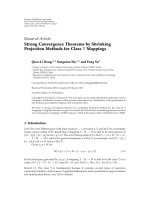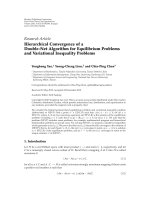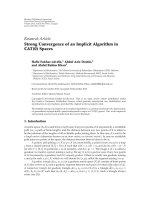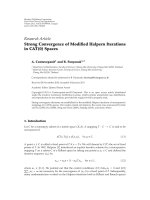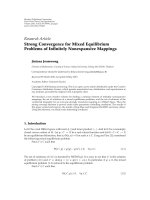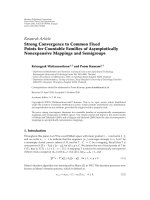Báo cáo hóa học: " Research Article Strong Convergence Theorems by Shrinking Projection Methods for Class T Mappings" pptx
Bạn đang xem bản rút gọn của tài liệu. Xem và tải ngay bản đầy đủ của tài liệu tại đây (471.36 KB, 7 trang )
Hindawi Publishing Corporation
Fixed Point Theory and Applications
Volume 2011, Article ID 681214, 7 pages
doi:10.1155/2011/681214
Research Article
Strong Convergence Theorems by Shrinking
Projection Methods for Class
T Mappings
Qiao-Li Dong,
1, 2
Songnian He,
1, 2
and Fang Su
3
1
College of Science, Civil Aviation University of China, Tianjin 300300, China
2
Tianjin Key Laboratory for Advanced Signal Processing, Civil Aviation University of China,
Tianjin 300300, China
3
Department of Mathematics and Systems Science, National University of Defense Technology,
Changsha 410073, China
Correspondence should be addressed to Qiao-Li Dong,
Received 9 December 2010; Accepted 2 February 2011
Academic Editor: S. Al-Homidan
Copyright q 2011 Qiao-Li Dong et al. This is an open access article distributed under the Creative
Commons Attribution License, which permits unrestricted use, distribution, and reproduction in
any medium, provided the original work is properly cited.
We prove a strong convergence theorem by a shrinking projection method for the class of
T
mappings. Using this theorem, we get a new result. We also describe a shrinking projection method
for a nonexpansive mapping on Hilbert spaces, which is the same as that of Takahashi et al. 2008.
1. Introduction
Let H be a real Hilbert space with inner product ·, · and norm ·,andletC be a nonempty
closed convex subset of H. Recall that a mapping T : H → H is said to be nonexpansive if
Tx− Ty≤x − y for all x, y ∈ H. The set of fixed points of T is FixT : {x ∈ H : Tx x}.
T : H → H is said to be quasi-nonexpansive if FixT is nonempty and Tx − p≤
x − p for all x ∈ H and p ∈ FixT.
Given x, y ∈ H,let
H
x, y
:
z ∈ H :
z
− y, x − y
≤ 0
1.1
be the half-space generated by x, y. A mapping T : H → H is said to be the class T or a
cutter if T ∈ T {T : H → H | domTH and FixT ⊂ Hx, Tx, for all x ∈ H}.
Remark 1.1. The class T is fundamental because it contains several types of operators
commonly found in various areas of applied mathematics and in particular in approximation
and optimization theory see 1 for details.
2 Fixed Point Theory and Applications
Combettes 2, Bauschke, and Combettes 1 studied properties of the class T
mappings and presented several algorithms. They introduced an abstract Haugazeau method
in 1 as follows: starting x
0
∈ H,
x
n1
P
Hx
0
,x
n
∩Hx
n
,T
n
x
n
x
0
. 1.2
Using Lemma 1.2 given below and the fact that a nonexpansive mapping is quasi-
nonexpansive, one can easily obtain hybrid methods introduced by Nakajo and Takahashi
3 for a nonexpansive mapping.
Recently, Takahashi et al. 4 proposed a shrinking projection method for nonexpan-
sive mappings T
n
: C → C.Letx
0
∈ H, C
1
C, x
1
P
C
1
x
0
,and
y
n
α
n
1 − α
n
T
n
x
n
,
C
n1
z ∈ C
n
: y
n
− z≤x
n
− z
,
x
n1
P
C
n1
x
0
,n 1, 2, ,
1.3
where 0 ≤ α
n
≤ a<1, P
K
denotes the metric projection from H onto a closed convex subset
K of H.
Inspired by Bauschke and Combettes 1 and Takahashi et al. 4, we present a
shrinking projection method for the class of T mappings. Furthermore, we obtain a shrinking
projection method for a nonexpansive mapping on Hilbert spaces, which is the same as
presented by Takahashi et al. 4.
We will use the following notations:
1 for weak convergence and → for strong convergence;
2 ω
w
x
n
{x : ∃x
n
j
x} denotes the weak ω-limit of {x
n
}.
We need some facts and tools in a real Hilbert space H which are listed below.
Lemma 1.2 see 1. Let H be a Hilbert space. Let I be the identity operator of H.
i If dom T H,then2T − I is quasi-nonexpansive if and only if T ∈ T.
ii If T ∈ T,thenλI 1 − λT ∈ T, for all λ ∈ 0, 1.
Definition 1.3. Let T
n
∈ T for each n. The sequence {T
n
} is called to be coherent if, for every
bounded sequence {v
n
} in H, there holds
∞
n0
v
n1
− v
n
2
< ∞,
∞
n0
v
n
− T
n
v
n
2
< ∞,
⇒ ω
w
v
n
⊂
∞
n0
Fix
T
n
. 1.4
Definition 1.4. T is called demiclosed at y ∈ H if Tx y whenever {x
n
}⊂H, x
n
xand
Tx
n
→ y.
Next lemma shows that nonexpansive mappings are demeiclosed at 0.
Fixed Point Theory and Applications 3
Lemma 1.5 Goebel and Kirk 5. Let C be a closed convex subset of a real Hilbert space H, and
let T : C → C be a nonexpansive mapping such that FixT
/
∅. If a sequence {x
n
} in C is such that
x
n
zand x
n
− Tx
n
→ 0,thenz Tz.
Lemma 1.6 see 6. Let K be a closed convex subset of H.Let{x
n
} be a sequence in H and u ∈ H.
Let q P
K
u.Ifx
n
is such that ω
w
x
n
⊂ K and satisfies the condition
x
n
− u≤u − q, ∀n, 1.5
then x
n
→ q.
Lemma 1.7 Goebel and Kirk 5. Let K be a closed convex subset of real Hilbert space H, and let
P
K
be the (metric or nearest point) projection from H onto K (i.e., for x ∈ H, P
K
x is the only point
in K such that x − P
K
x inf{x − z : z ∈ K}). Given x ∈ H and z ∈ K,thenz P
K
x if and
only if there holds the relation
x − z, y − z
≤ 0, ∀y ∈ K. 1.6
2. Main Results
In this section, we will introduce a shrinking projection method for the class of T mappings
and prove strong convergence theorem.
Theorem 2.1. Let T
n
∈ T for each n such that F :
∞
n1
FixT
n
/
∅. Suppose that the sequence {T
n
}
is coherent. Let x
0
∈ H. For C
1
H and x
1
x
0
, define a sequence {x
n
} as follows:
x
n1
P
C
n1
x
0
,n 1, 2, ,
C
n1
{
z ∈ C
n
:
z − T
n
x
n
,x
n
− T
n
x
n
≤ 0
}
.
2.1
Then, {x
n
} converges strongly to P
F
x
0
.
Proof. We first show by induction that F⊂C
n
for all n ∈ N.F⊂C
1
is obvious. Suppose
F⊂C
k
for some k ∈ N. Note that, by the definition of T
k
∈ T, we always have F⊂FixT
k
⊂
Hx
k
,T
k
x
k
,thatis,
z − T
k
x
k
,x
k
− T
k
x
k
≤ 0, ∀z ∈F. 2.2
From the definition of C
k1
and F⊂C
k
,weobtainF⊂C
k1
. This implies that
F⊂C
n
, ∀n ∈ N. 2.3
It is obvious that C
1
H is closed and convex. So, from the definition, C
n
is closed and convex
for all n ∈ N.Sowegetthat{x
n
} is well defined.
Since x
n
is the projection of x
0
onto C
n
which contains F, we have
x
0
− x
n
≤x
0
− y, ∀y ∈ C
n
. 2.4
4 Fixed Point Theory and Applications
Taking y P
F
x
0
∈F,weget
x
0
− x
n
≤x
0
− P
F
x
0
. 2.5
The last inequality ensures that {x
0
− x
n
} is bounded. From x
n
P
C
n
x
0
and x
n1
P
C
n1
x
0
∈
C
n1
⊂ C
n
,usingLemma 1.7,weget
x
n1
− x
n
,x
0
− x
n
≤ 0. 2.6
It follows that
x
0
− x
n1
2
x
0
− x
n
−
x
n1
− x
n
2
x
0
− x
n
2
− 2
x
0
− x
n
,x
n1
− x
n
x
n1
− x
n
2
≥
x
0
− x
n
2
x
n1
− x
n
2
≥
x
0
− x
n
2
.
2.7
Thus {x
n
− x
0
} is increasing. Since {x
n
− x
0
} is bounded, lim
n →∞
x
n
− x
0
exists. From
2.7, it follows that
x
n1
− x
n
2
≤
x
0
− x
n1
2
−
x
0
− x
n
2
,
2.8
and
∞
n1
x
n1
− x
n
2
< ∞. On the other hand, by x
n1
P
C
n1
x
0
∈ C
n1
, we have
x
n1
− T
n
x
n
,x
n
− T
n
x
n
≤ 0. 2.9
Hence,
x
n1
− x
n
2
x
n1
− T
n
x
n
− x
n
− T
n
x
n
2
x
n1
− T
n
x
n
2
− 2
x
n1
− T
n
x
n
,x
n
− T
n
x
n
x
n
− T
n
x
n
2
≥
x
n1
− T
n
x
n
2
x
n
− T
n
x
n
2
.
2.10
We therefore get
∞
n1
x
n
− T
n
x
n
2
< ∞. Since the sequence {T
n
} is coherent, we have
ω
w
x
n
⊂F.FromLemma 1.6 and 2.5, the result holds.
Remark 2.2. We take C
1
H so that F⊂C
1
is satisfied.
Fixed Point Theory and Applications 5
Theorem 2.3. Let T
n
∈ T for each n such that F :
∞
n1
FixT
n
/
∅. Suppose that the sequence {T
n
}
is coherent. Let x
0
∈ H. For C
1
H and x
1
x
0
, define a sequence {x
n
} as follows:
y
n
α
n
x
n
1 − α
n
T
n
x
n
,
C
n1
z ∈ C
n
:
z − y
n
,x
n
− y
n
≤ 0
,
x
n1
P
C
n1
x
0
,n 1, 2, ,
2.11
where 0 ≤ α
n
≤ a<1. Then, {x
n
} converges strongly to P
F
x
0
.
Proof. Set S
n
α
n
I 1 − α
n
T
n
.ByLemma 1.2 ii, we have that S
n
∈ T.Fromx
n
− S
n
x
n
1 − α
n
x
n
− T
n
x
n
, it follows that 1 − ax
n
− T
n
x
n
≤x
n
− S
n
x
n
≤x
n
− T
n
x
n
which
implies that the sequence {S
n
} is coherent. It is obvious that FixS
n
FixT
n
, for all n ∈ N.
Hence F
∞
n1
FixS
n
∞
n1
FixT
n
.UsingTheorem 2.1, we get the desired result.
3. Deduced Results
In this section, using Theorem 2.3, we obtain some new strong convergence results for the
class of T mappings, a quasi-nonexpansive mapping and a nonexpansive mapping in a
Hilbert space.
Theorem 3.1. Let T ∈ T such that FixT
/
∅ and satisfying that I −T is demiclosed at 0. Let x
0
∈ H.
For C
1
H and x
1
x
0
, define a sequence {x
n
} as follows:
y
n
α
n
x
n
1 − α
n
Tx
n
,
C
n1
z ∈ C
n
: z − y
n
,x
n
− y
n
≤0
,
x
n1
P
C
n1
x
0
,n 1, 2, ,
3.1
where 0 ≤ α
n
≤ a<1. Then, {x
n
} converges strongly to P
FixT
x
0
.
Proof. Let T
n
T in 2.11 for all n ∈ N. Following the proof of Theorem 2.1, we can easily
get 2.5 and
∞
n1
x
n
− Tx
n
2
< ∞.By2.5,weobtainthat{x
n
} is bounded and ω
w
x
n
is
nonempty. For any x ∈ ω
w
x
n
, there exists a subsequence {x
n
j
} of the sequence {x
n
} such
that x
n
j
x.From
∞
n1
x
n
− Tx
n
2
< ∞, it follows that x
n
− Tx
n
→0. Since I − T is
demiclosed at 0, we get x ∈ FixT.Thusω
w
x
n
⊂ FixT which together with Lemma 1.6
and 2.5 implies that x
n
→ P
FixT
x
0
.
Theorem 3.2. Let H be a Hilbert space. Let S be a quasi-nonexpansive mapping on H such that
FixS
/
∅ and satisfying that I − S is demiclosed at 0. Let x
0
∈ H. For C
1
H and x
1
x
0
, define a
sequence {x
n
} as follows:
u
n
α
n
x
n
1 − α
n
Sx
n
,
C
n1
{
z ∈ C
n
: z − u
n
≤x
n
− z
}
,
x
n1
P
C
n1
x
0
,n 1, 2, ,
3.2
where 0 ≤ α
n
≤ a<1. Then, {x
n
} converges strongly to P
FixS
x
0
.
6 Fixed Point Theory and Applications
Proof. By Lemma 1.2i, S I/2 ∈ T. Substitute T in 3.1 by S I/2. Then y
n
1
α
n
/2x
n
1 − α
n
/2Sx
n
.Setu
n
2y
n
− x
n
α
n
x
n
1 − α
n
Sx
n
, then y
n
u
n
x
n
/2. So,
we have
C
n1
z ∈ C
n
:
z − y
n
,x
n
− y
n
≤ 0
{
z ∈ C
n
:
2z −
x
n
u
n
,x
n
− u
n
≤ 0
}
{
z ∈ C
n
: z − u
n
≤x
n
− z
}
.
3.3
Since I − S is demiclosed at 0, I − S I/2 I − S/2 is demiclosed at 0. So we can obtain
the result by using Theorem 3.1.
Since a nonexpansive mapping is quasi-nonexpansive, using Lemma 1.5 and
Theorem 3.2, we have following corollary.
Corollary 3.3. Let H be a Hilbert space. Let S be a nonexpansive mapping H such that FixS
/
∅.
Let x
0
∈ H. For C
1
H and x
1
x
0
, define a sequence {x
n
} as follows:
u
n
α
n
x
n
1 − α
n
Sx
n
,
C
n1
{
z ∈ C
n
: z − u
n
≤x
n
− z
}
,
x
n1
P
C
n1
x
0
,n 1, 2, ,
3.4
where 0 ≤ α
n
≤ a<1. Then, {x
n
} converges strongly to P
FixS
x
0
.
Remark 3.4. Corollary 3.3 is a special case of Theorem 4.1 in 4 when C
1
H.
Acknowledgments
The authors would like to express their thanks to the referee for the valuable comments and
suggestions for improving this paper. This paper is supported by Research Funds of Civil
Aviation University of China Grant 08QD10X and Fundamental Research Funds for the
Central Universities Grant ZXH2009D021.
References
1 H. H. Bauschke and P. L. Combettes, “A weak-to-strong convergence principle for Fej
´
er-monotone
methods in Hilbert spaces,” Mathematics of Operations Research, vol. 26, no. 2, pp. 248–264, 2001.
2 P. L. Combettes, “Quasi-Fej
´
erian analysis of some optimization algorithms,” in Inherently Parallel
Algorithms in Feasibility and Optimization and Their Applications, vol. 8, pp. 115–152, North-Holland,
Amsterdam, The Netherlands, 2001.
3 K. Nakajo and W. Takahashi, “Strong convergence theorems for nonexpansive mappings and
nonexpansive semigroups,” Journal of Mathematical Analysis and Applications, vol. 279, no. 2, pp. 372–
379, 2003.
4 W. Takahashi, Y. Takeuchi, and R. Kubota, “Strong convergence theorems by hybrid methods for
families of nonexpansive mappings in Hilbert spaces,” Journal of Mathematical Analysis and Applications,
vol. 341, no. 1, pp. 276–286, 2008.
Fixed Point Theory and Applications 7
5 K. Goebel and W. A. Kirk, Topics in Metric Fixed Point Theory, vol. 28 of Cambridge Studies in Advanced
Mathematics, Cambridge University Press, Cambridge, UK, 1990.
6 C. Martinez-Yanes and H K. Xu, “Strong convergence of the CQ method for fixed point iteration
processes,” Nonlinear Analysis. Theory, Methods & Applications, vol. 64, no. 11, pp. 2400–2411, 2006.



